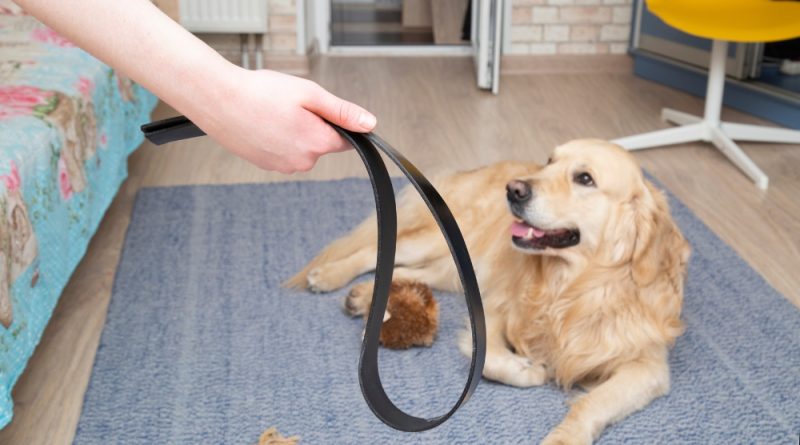Does putting the dog in timeout solve the issue?
In this article, we’ll delve a bit more into putting a dog in timeout: does it really work, or is it just an illusion?
The truth is, numerous circumstances need to be considered. After all, punishing just for the sake of punishment is never a good approach. However, thoughtful and strategic isolation can indeed make a difference.
Whether you are a first-time pet owner or seeking to understand more about training and a healthy relationship with your best friend, keep reading.
Putting a dog in timeout – Is it advisable?
Putting a dog in timeout may seem like a promising situation in terms of setting boundaries. After all, we are accustomed, from childhood, to the idea that “timeout” helps to show what is allowed and what is not.
However, things are not as simple as they may seem.
A little dog, when feeling confined or isolated, may not link it to a limit due to something it did. After all, it’s not rational and will never understand that it is “in timeout” for something it did.
So, putting a dog in timeout is not advisable under any circumstances.
However, we cannot simply discard the idea that space limitation or isolation may be detrimental to a dog. In this case, yes, these situations can be helpful.
It all depends on the circumstances established for the pet to understand that it is isolated for a reason.
For example, if your dog is barking like crazy at home, and you want it to stop, just locking it in a room will not solve the issue. On the contrary, it may worsen the situation.
However, strategic isolation designed to define the dog’s living space can be useful. Especially when the dog has just arrived in a new home. In this case, limiting space helps the dog feel less stressed and anxious.
In summary, everything is related to the context. Putting a dog in timeout in a punitive context is not advisable. However, isolating it for learning situations can be important.
Putting a dog in timeout – Isolation creates inconsistency
One of the most serious problems related to isolating a dog is inconsistency. In other words, your best friend may not understand commands and may become even more stressed the moment it is isolated.
Putting a dog in timeout can make the dog not comprehend the limits and daily routines. After all, when it does something wrong, the owner simply isolates it. In reality, this delays the animal’s learning for positive conditioning.
When making a mistake, we should not punish the dog. However, some reprimands can occur.
For example, a loud clap in the room to create a strident noise can cause a pattern interruption. This helps a lot when the animal shifts focus from the bad behavior.
If it’s locked up, you won’t even have the opportunity to teach it what is right.
Dogs are not rational, and they won’t understand that being “locked up” is a punishment. It is essential to teach them through training methods and positive reinforcement.
To help you, below is a list of ideas that can replace punishment with something better that really helps the dog. Read on.
How to replace a dog’s timeout
By now, if putting the dog in timeout solves the issue, we understand that simply putting it there is not worth it.
After all, the animal won’t understand that it is being punished for something it did wrong and may develop even worse behaviors.
Moreover, anxiety and stress may take over the animal’s routine.
Therefore, to help you, we have compiled a list of ideas that can replace punishment with something more coherent and interesting for training the dog.
Here are some ideas:
- Positive reinforcement for correct situations.
- Surprises or attention breaks.
- Basic commands early in the dog’s life.
- Canine socialization can help the dog not feel “exclusive.”
- Isolation does not have to be a punishment.
- “Attention” is the keyword that conditions the dog to something.
- Keep reading to understand more about each of these alternatives.
Putting a dog in timeout – Positive reinforcement for correct situations
If there’s one thing crucial for a balanced routine, it’s positive reinforcement. That is, positively reinforcing a situation so that the dog repeats it consistently.
Positive reinforcement, for those considering putting the dog in timeout, is an interesting and viable alternative. Instead of punishing the dog for doing something wrong, positive reinforcement encourages the dog after a correct action.
How so?
Basically, every time your best friend does something right in daily life, it should be rewarded for it.
This reward can come in the form of a dog treat, petting, praise, a walk, or whatever works. The important thing is for the dog to like it and realize that you gave it something good for a particular behavior.
In positive reinforcement, every millisecond counts. That is, as soon as your little dog performs a certain behavior correctly, give the treat immediately. It needs to associate the behavior with the treat. Otherwise, things won’t work, okay?
By conditioning your best friend this way, it will be easier for it to understand what it can and cannot do. It will begin to repeat good manners due to the conditioning of receiving a reward for it.
Surprises or attention breaks
Another factor that helps a lot when teaching a little dog is pattern interruptions.
That is, by putting the dog in timeout, you will hardly succeed in teaching certain behaviors. After all, you will be away, and the animal will not be absorbing any learning – as it will be isolated.
One tip that can help, for example, is: when the dog is barking inside the house or jumping on visitors, clap your hands loudly.
Or create another type of noise to “break” the dog’s focus on what it is doing. This way, it will shift focus from the “outburst,” and you won’t need to punish or scold it.
Pattern interruptions in situations of negative behaviors are quite interesting and can be used in daily life.
Basic commands early in the dog’s life
After all, does putting the dog in timeout solve the issue or not? The beginning of a dog’s life is one of the best times to instill good behaviors. After all, it does not yet have established canine habits, and learning good behaviors will be easier.
Therefore, as soon as you adopt a puppy, start using positive reinforcement and teach it basic commands.
Basic commands like “sit,” “stay,” and “no” help the owner have better control over the dog’s routine, and it does not become so anxious or stressed by things in daily life.
Basic commands, when taught early in a puppy’s life, help it stay calmer and more relaxed in the environment, and there is not so much stress for learning.
Canine socialization can help the dog not feel “exclusive”
Putting the dog in timeout goes against something that is crucial for all dogs: socialization. Yes, dogs need to socialize too. This helps them be calmer, more patient, and more tolerant of other people and animals.
So, if it is isolated all the time, it may bring a feeling of “control” for the owner. However, in the long run, this is very bad for the pet.
Spending energy meeting other dogs and sniffing the park during a walk is fundamental. After all, the dog needs to be a “dog” to have a quality life.
Always remember this when thinking about leaving your dog locked inside. It is not a stuffed teddy bear, okay?
Isolation does not have to be a punishment
On the other hand, punishment should not be confused with isolation.
That is, locking the dog in a room after it did something wrong is not positive. However, isolating the animal, especially in the first few days in a new home, can help it become less stressed.
If you are moving to a new home or adopting a puppy, leaving it in a single room in the first few days may be beneficial.
This way, the animal won’t have “thousands” of stimuli, and it can focus on adapting to you without worrying about many other things around it.
“Attention” is the keyword that conditions the dog to something
Lastly, here’s something essential that all owners must understand: dogs want attention. Everything they do is to get the owner’s attention.
So, if they do something wrong or bark all the time, it’s to get attention. Even if you “scold” or “punish” the dog, it doesn’t solve the issue and makes the dog understand that it got attention.
In the long run, it will condition barking and wrong behaviors as a way to get your attention.
Now, whether putting the dog in timeout solves the issue or not, positive reinforcement is crucial for the dog! Take good care of your best friend.




